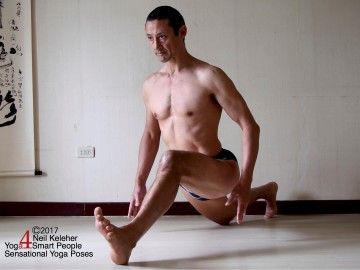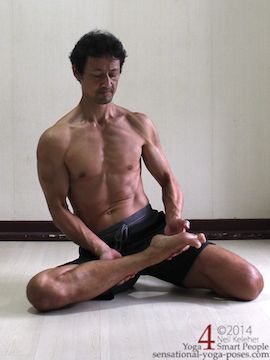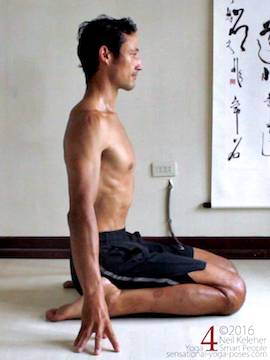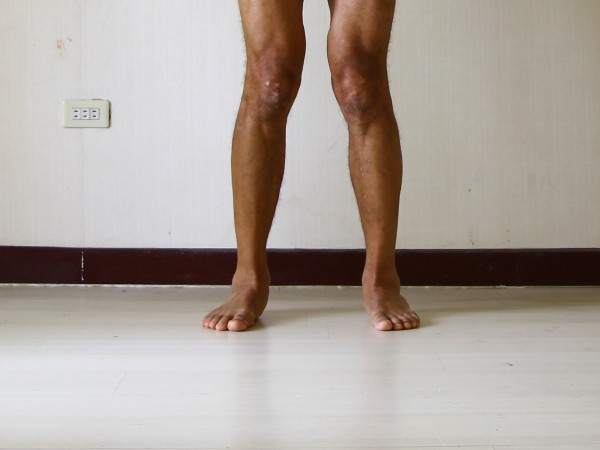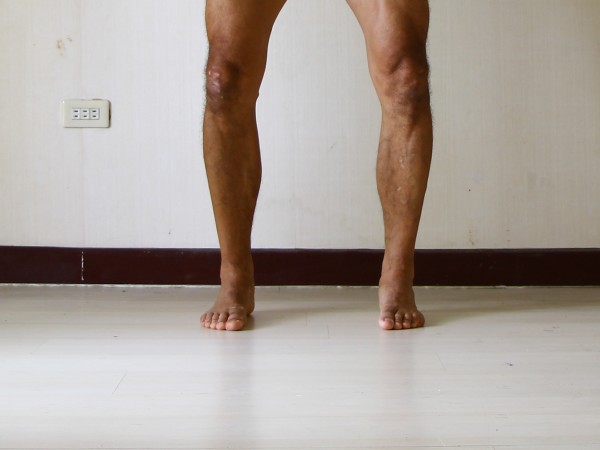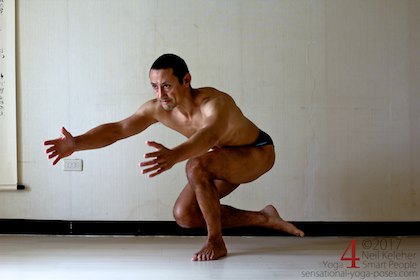How to the calf muscles relate to knee strength (and knee strengthening)?
First of all some calf anatomy.
There are two main calf muscles, the soleus and the gastrocnemius. Both attach to the heel, so they both work cross the ankle and can have an affect on it and the foot.
The soleus attaches to the fibular and tibia, the two lower leg bones. The gastrocnemius crosses the knee joint and attaches to the femur, the thigh bone, just above the knee.
Both muscles are important in knee stability and making the knee strong.
Why do the shins rotate when the knes are bent? What are the advantages of this?
One of the possible movements of the knee, particularly when the knee is bent, is rotation of the shin relative to the thigh or vice versa. This rotation is what allows us to move into leg postions like lotus pose or janu sirsasana c or hero (representations of these leg positions are shown, in order, left to right, below).
Rotation can also happen at the ankle joint, sort of. You can see my shins rolled inwards, and then outwards relative to my feet in the two pictures below.
Standing with knees straight or bent, you can rotate your shins relative to your feet.
If you do this with the knees straight then the thighs and lower legs will rotate together as one unit. If you do it with the knees bent, then the shins rotate relative to the thighs as well as the feet.
Stabilizing the Legs Against Rotation From the Hips Downwards
With the leg straight it is possible to stabilize the legs against rotation from the hip downwards.
Using the pelvis as a foundation or reference you could potentially use the tensor fascae latae and glute max (via the IT band), the gracilis, sartorius, semitendinosus and biceps femoris long head to stabilize the shin and thus the thigh as well.
All together, these can be referred to as the long hip muscles.
The trouble with that strategy is that it potentially limits hip control options, which isn't always a bad thing.
So what's another option for creating stability against rotation? The calf muscles.
Anchoring the heels with body weight
With the heel anchored in a standing pose, either anchored by the weight of the body or by tension in the foot (or a combination of both) the soleus and gastrocnemius have a stable foundation from which to act on the back of the lower leg bones and the femur. Since both muscles attach laterally and medially, they can be used to help resist rotation of the shin relative to the foot. This then provides a foundation for the aforementioned muscles (that would otherwise have been used to stabilize against rotation) to actually control the pelvis.
Get a feel for shin rotation (so that you can then stabilize against shin rotation)
To create this kind of stability it helps to have practiced rotating the lower legs relative to the feet. This was one of the first foot exercises I learned and it actually helped me un-collapse my arches and get me into the army. (It was a way of hiding my "flat" feet).
Stabilizing the Legs Against Rotations From the Feet Upwards
With a feel for what it is like to rotate the shins, part of the method for using the calfs to stabilize the lower leg and knee is to activate the calfs in such a way that the lower leg feels rotationally stable. Ironically, perhaps, it can help to rotate the shins in one direction or another while activating the calfs to find the position where the lower leg feels most stable.
To ensure stability of the knee (and not just the lower leg) make sure the two sets of tendons on either side of the back of the knee are also active.
Here's a bit more on the anatomy that works on the knees.
Anchoring the Fibula (for stronger knees)
When active, the soleus can create a downwards pull on the fibula. You could think of this as making the fibular more resistant to being pulled upwards.
The biceps femoris attaches to the fibula and so creating a downward pull on the fibula, via the soleus, gives this latter muscle a stable foundation from which to act on the femur and pelvis.
So soleus activation is potentially important not just to resist rotation of the lower leg but also important as an anchoring mechanism (part of it) for the fibula which in turn acts as an anchor for the biceps femoris. In the process it helps to stabilize the knee or make it stronger.
Making the back of the knee strong with the gastrocnemius
The tendons of the gastrocnemius interlock with those of the hamstrings. When engaged the tendons of that calf muscle push outwards on the hamstring tendons, which in turn adds some tension to the hamstrings. How much this affects the hamstrings can depend on the amount of bend in the knee and the amount of bend in the hip.
Of the biceps femoris's two heads, only the short head attaches directly to the femur. This portion of the muscle could be thought of as being not directly affected by the position of the hip joint. (It can be affected indirectly due to tension in the other hamstring muscles.)
Tension in the Gastrocnemius tendon (particular the outer or lateral one) can add tension to the short head of the biceps femoris making it easier to activate, thus helping to strengthen the knee joint and make it more stable, particularly when bent, and, from my own experience, when supporting weight as in a low squat.
Calf tension not only makes the knees stronger, it can help Hip Stability
My own experience is that calf tension not only makes the knee stronger and more stable, it also can have an affect on hip stability (which in view of rotational stability, which I talked about above, makes sense).
I've been experimenting for a long time with different hip muscle activations, in particular because I've had some hip problems. While valuable for helping me get to know my body and control it, they haven't helped my hip, at least not long term.
With calf activation I notice the deepest impact on my hip pain. It's almost like if I want to fix my hip problem, then make sure the calf is active, stabilizing the knee, then work on the hip.
At any rate, I've found calf activation as a way of knee strengthening helpful in exercises like the seated get up.
I've also found it helpful in front squats (with weight.) I haven't done back squats with this knee strengthening activation yet, but I look forward to trying.
It can also be useful if working towards the splits. In the pose pictured at the top of the page, you could engage the calf of the front leg, make the back of the knee strong and then from there also make the hamstrings strong.
Learn to feel the back of your knee (and activate it)
Not sure how to make the back of your knee feel strong? Smart yogi-proprioceptive elements includes exercises for learning to feel the back of the knee as well as a host of other basic body awareness elements. It's like a basic Drivers Ed (eduction) course for your body. Doing the exercises contained in this program is also a lot like learning to ride a bike. Once you've learned them, you develop the ability to feel and control various parts of your body, and that's difficult to forget.
You can use this link to Purchase Smart yogi-proprioceptive elements or use this link to find out more about Smart yogi-proprioceptive elements
Published: 2017 03 27
Updated: 2021 02 11
